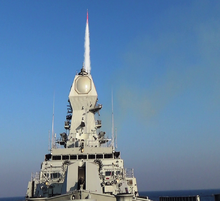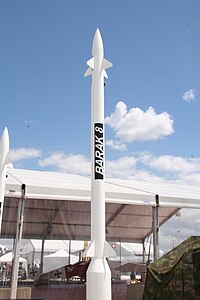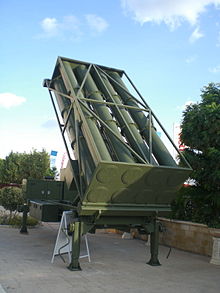Barak 8 (the Hebrew word for Lightning) also known as LR-SAM is an Indian-Israelisurface-to-air missile (SAM), designed to defend against any type of airborne threat including aircraft, helicopters, anti-ship missiles, and UAVs as well as cruise missiles and combat jets out to a maximum range of 70 km, however, reports suggest the missile has been increased to a maximum range of 90 km following "range upgrade discussions" between India and Israel during November 2014.[7][8] Some news agencies have referred to the missiles range at 100 km. Both maritime and land-based versions of the system exist.
Barak 8 was jointly developed by Israel Aerospace Industries (IAI), India's Defence Research & Development Organisation (DRDO), Israel's Administration for the Development of Weapons and Technological Infrastructure, Elta Systems, Rafael and other companies. Bharat Dynamics Limited (BDL) will produce the missiles. The Israeli Navy has commenced equipping its Sa'ar 5corvettes with the system, the first re-fitted vessel being the INS Lahav. The Sa'ar 4.5flotilla will be next for the upgrade. The first 32 missile array will be fitted on the Indian Navy stealth guided-missile destroyerINS Kolkata (D63).
Background
Barak 8 is based on the original Barak 1 missile and is expected to feature a more advanced seeker, alongside range extensions that will move it closer to medium range naval systems like the RIM-162 ESSM or even the SM-2 Standard. Israel successfully tested its improved Barak II missile on July 30, 2009. The radar system provides 360 degree coverage and the missiles can take down an incoming missile as close as 500 meters away from the ship. Each Barak system (missile container, radar, computers and installation) costs about $24 million. In November 2009 Israel signed a $1.1 billion contract to supply an upgraded tactical Barak 8 air defence system to India.
Characteristics
The Barak 8 has a length of about 4.5 meters, a diameter of 0.225 meters[6] at missile body, and 0.54 meters at the booster stage, a wingspan of 0.94 meters and weighs 275 kg including a 60 kg warhead which detonates at proximity. The missile has maximum speed of Mach 2 with a maximum operational range of 70 km, which was later increased to 100 km. Barak 8 features a dual pulse rocket motor as well as Thrust vector control, and possesses high degrees of maneuverability at target interception range. A second motor is fired during the terminal phase, at which stage the active radar seekeris activated to home in on to the enemy track. Barak 8 has been designed to counter a wide variety of air-borne threats, such as; anti-ship missiles, aircraft, UAVs drones and supersonic missiles. When coupled with a modern air-defence system and multi-function surveillance track and guidance radars, (such as the EL/M-2248 MF-STARAESA on board the Kolkata-class destroyers) Barak 8 enables the capability to simultaneously engage multiple targets during saturation attacks.
Israel Aerospace Industries describe Barak 8 as "an advanced, long-range missile defense and air defense system" with its main features being:
- Long Range
- Two way data link (GPS S band)
- Active Radar Seeker Missile
- 360 degree coverage
- Vertical Launch
- Multiple Simultaneous Engagements
Barak 8 has been described as giving potential use as a point defence anti-ballistic missile due to its combination of advanced capabilities.
Barak-8ER
It has been reported that an ER (extended range) variant of the Barak 8 is under development, which will see the missiles maximum range increased to 150 km. Designed to engage multiple beyond visual range threats, the low launch signature Barak-8ER is understood to retain the same autopilot/inertial navigation system and active radar seeker guidance as the Barak-8, although some modifications to the software and to the missile control surfaces are likely. The booster increases the length of the missile at launch from its current 4.5 m to nearly 6 m, although the length in flight after the booster has been jettisoned may be slightly less than the base Barak-8 missile, if a TVC is not present. The missile diameter and fin spans are thought to be the same as the base Barak-8. The booster weight is currently unknown, although the missile's weight after the booster has been jettisoned is the same as that for the current Barak-8 configuration.
Levy said that initial operational capability (IOC) for Barak-8ER will first be declared for the naval variant, followed by IOC for the land variant. He declined to comment on a launch customer for Barak-8ER, but noted "existing Barak-8 customers will be interested in this configuration because it offers additional capability to their current system". The missile is expected to equip the Indian Navys future Visakhapatnam-class destroyers.
Flight tests

INS Kolkata firing a Barak 8 missile.
- In May 2010, the Barak-II missile was successfully test fired at an electronic targetand met its initial objectives. The second test of the missile was to be held in India later in 2010. "More than 70 per cent of the content in the missile being developed with Israel would be indigenous." DRDO chief V. K. Saraswat told The Economic Times.
- On 10 November 2014 the Barak 8 was successfully test fired in Israel with all integrated operational components for both the marine & land system.
- On 26 November 2015, a successful test was conducted on a drone target.
- On 29 December 2015 and 30 December 2015 the Indian Navy successfully test-fired the Barak 8 missile from INS Kolkata. Two missiles were fired at high speed targets, during naval exercises being undertaken in the Arabian Sea.
- On 30 June 2016, India test-fire a land based version of Barak 8 surface-to-air missiles for the first time from their defence Integrated Test Range (ITR), off theChandipur, Odisha coast, successfully hitting the target pilotless target aircraft (PTA)at 08.15 AM. the missile was again test fired for second time around noon where it again successfully hit a pilotless target aircraft over the Bay of Bengal. The test-firing of the missile was jointly carried out by Indian defence personnel, DRDO and Israel Aerospace Industries.
- On July 1st 2016 the MR SAM (land based version) was tested for the third time from the integrated test range at chandipur, at 10:26 am and the missile successfully hit a pilotless target aircraft, proving its reliability.
- On 20 september 2016 India successfully test fires surface-to-air missile Barak-8
Operators
Current operators
 Israel – By February 2017, Israel'sSa'ar 5-class corvettes to carry the newer Barak 8 missile system, instead of Barak 1. To that end, INS Lahav, a Sa'ar 5-class corvette live-fired the Barak 8 missile system, during a trial in late 2015. Subsequently, the navy will convert lighter Sa'ar 4.5-class corvettes in two to three years.
Israel – By February 2017, Israel'sSa'ar 5-class corvettes to carry the newer Barak 8 missile system, instead of Barak 1. To that end, INS Lahav, a Sa'ar 5-class corvette live-fired the Barak 8 missile system, during a trial in late 2015. Subsequently, the navy will convert lighter Sa'ar 4.5-class corvettes in two to three years. India – for Kolkata-class destroyers,Visakhaptnam-class destroyers, Kamorta-class corvettes, INS Vikramaditya, INSVikrant and Project 17A frigates
India – for Kolkata-class destroyers,Visakhaptnam-class destroyers, Kamorta-class corvettes, INS Vikramaditya, INSVikrant and Project 17A frigates
Potential operators
 Azerbaijan
Azerbaijan Chile
Chile Germany
Germany Poland – In 2014, Polish Navy evaluated Barak 8 missile system, for potential use in their ships.
Poland – In 2014, Polish Navy evaluated Barak 8 missile system, for potential use in their ships.



No comments:
Post a Comment